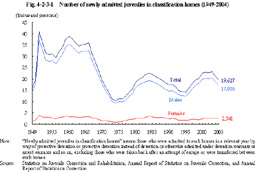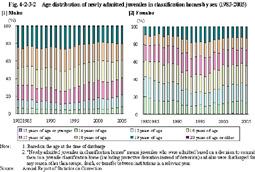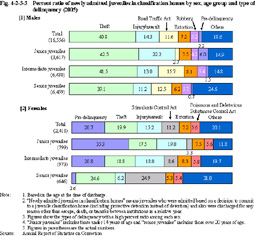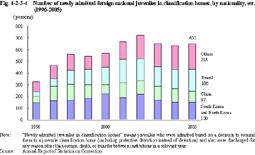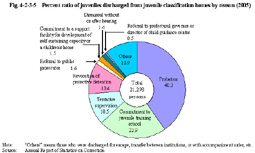| Previous Next Index Image Index Year Selection | |
|
|
1 Admission and discharge (1) Number of newly admitted juveniles in classification homes Fig. 4-2-3-1 shows the number of juveniles newly admitted to juvenile classification homes since 1949.
Fig. 4-2-3-1 Number of newly admitted juveniles in classification homes (1949-2004) The number of newly admitted juveniles increased from 1996, marking a record high since 1970 in 2003, but decreased compared to the previous year in 2004 and 2005 consecutively (See Appendix 4-11). Among newly admitted juveniles in 2005, those admitted by way of protective detention accounted for 85.5% and those by protective detention instead of detention accounted for 10.5% of the total. There were also very few juveniles admitted by way of detention or custody, etc. (Source: Annual Report of Statistics on Correction).(2) Characteristics of newly admitted juveniles Fig. 4-2-3-2 shows the age distribution of newly admitted juveniles in classification homes since 1983 by sex.
Fig. 4-2-3-2 Age distribution of newly admitted juveniles in classification homes by sex (1983-2005) Fig. 4-2-3-3 shows the percent ratio of newly admitted juveniles in classification homes in 2005 by the type of delinquency and by sex.Fig. 4-2-3-3 Percent ratio of newly admitted juveniles in classification homes by sex, age group and type of delinquency (2005) Fig. 4-2-3-4 shows the number of newly admitted foreign national juveniles since 1996, by nationality, etc.Fig. 4-2-3-4 Number of newly admitted foreign national juveniles in classification homes, by nationality, etc. (1996-2005) (3) Reasons for discharge Fig. 4-2-3-5 shows the percent ratio of juveniles discharged from juvenile classification homes by reason.
Fig. 4-2-3-5 Percent ratio of juveniles discharged from juvenile classification homes by reason (2005) |
